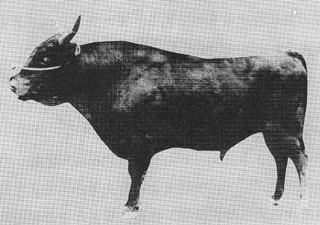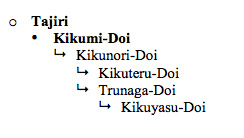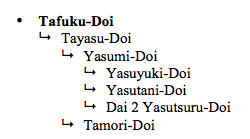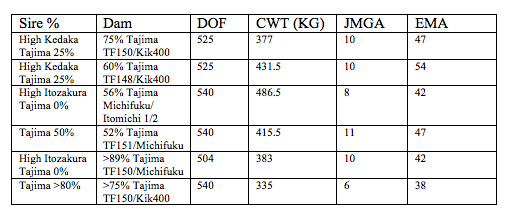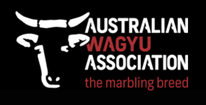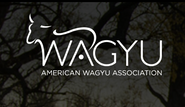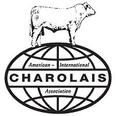Wagyu: Hyogo Prefecture (Tajima)
Introduction
Like Tottori, Okayama and Shimane, Hyogo Prefecture lies at the centre of Honshu in the heartland of the Japanese Black and its native Mishima ancestry. The foundation of world-famous Kobe-branded Black Wagyu beef, Hyogo’s Tajima-strain genetics – sharply focused on marbling traits have been supremely influential in Wagyu breeding outside Japan since the early 1990s.
Within Japan, Tajima is identified as a vital influence in the genetic composition of high performance Black Wagyu selected for marbling, growth and yield. But it is an isolated, quarantined – and increasingly inbred – family. Most of Black Wagyu recessive disorders and in-breeding difficulties can be located around Tajima breeding.
To Japanese commentators, the sharp focus on Tajima appears obsessive. An outcome of ‘Tajima tunnel vision’ has been the market segregation of high Tajima cross-bred herds from mainstream beef production, where feeder returns are based on weight. Until the severe feed price spike from 2006, this Wagyu niche was handsomely compensated for reduced growth and yield by high marbling premiums. With recession pressure from 2008, premiums now elude many crossbred producers.
For very high content purebred and fullblood Wagyu, a viable future may mean adopting breeding practices closer to Japanese methods.
Notwithstanding the difficulties of 2008-2009, the Tajima subpopulation of Hyogo remains the most famous (and some would say ‘most successful’) Japanese Black cattle strain in the world.
Like Tottori, Okayama and Shimane, Hyogo Prefecture lies at the centre of Honshu in the heartland of the Japanese Black and its native Mishima ancestry. The foundation of world-famous Kobe-branded Black Wagyu beef, Hyogo’s Tajima-strain genetics – sharply focused on marbling traits have been supremely influential in Wagyu breeding outside Japan since the early 1990s.
Within Japan, Tajima is identified as a vital influence in the genetic composition of high performance Black Wagyu selected for marbling, growth and yield. But it is an isolated, quarantined – and increasingly inbred – family. Most of Black Wagyu recessive disorders and in-breeding difficulties can be located around Tajima breeding.
To Japanese commentators, the sharp focus on Tajima appears obsessive. An outcome of ‘Tajima tunnel vision’ has been the market segregation of high Tajima cross-bred herds from mainstream beef production, where feeder returns are based on weight. Until the severe feed price spike from 2006, this Wagyu niche was handsomely compensated for reduced growth and yield by high marbling premiums. With recession pressure from 2008, premiums now elude many crossbred producers.
For very high content purebred and fullblood Wagyu, a viable future may mean adopting breeding practices closer to Japanese methods.
Notwithstanding the difficulties of 2008-2009, the Tajima subpopulation of Hyogo remains the most famous (and some would say ‘most successful’) Japanese Black cattle strain in the world.
Hyogo: Location & Background
Hyogo is known as ‘Japan in miniature’, with a wide range of attractions and industries that effectively represent modern Japan. The prefecture amalgamates several former provinces including Tajima in the north, which remains largely agricultural and one of five official districts. Coastlines include the Sea of Japan to the north and the Inland (Seto) Sea to the south.
Awaji Island lies between Honshu and Shikoku to the south and the world’s longest suspension bridge, Akashi Kaikyu, links Shikoku island to Honshu. Like many key Wagyu production areas, northern Hyogo is sparsely populated outside the city of Toyooka, and only a smattering of tiny villages populates the central highlands.
The greater population occupies the southern coast in the Osaka-Kyoto-Kobe metropolitan area. Summertime weather throughout Hyōgo is hot and humid. In winter, the north receives heavy snow from Siberian storms while the south is mild with occasional flurries.
Hyogo is known as ‘Japan in miniature’, with a wide range of attractions and industries that effectively represent modern Japan. The prefecture amalgamates several former provinces including Tajima in the north, which remains largely agricultural and one of five official districts. Coastlines include the Sea of Japan to the north and the Inland (Seto) Sea to the south.
Awaji Island lies between Honshu and Shikoku to the south and the world’s longest suspension bridge, Akashi Kaikyu, links Shikoku island to Honshu. Like many key Wagyu production areas, northern Hyogo is sparsely populated outside the city of Toyooka, and only a smattering of tiny villages populates the central highlands.
The greater population occupies the southern coast in the Osaka-Kyoto-Kobe metropolitan area. Summertime weather throughout Hyōgo is hot and humid. In winter, the north receives heavy snow from Siberian storms while the south is mild with occasional flurries.
Tajima Wagyu History
Tajima Province (但馬国, Tajima no Kuni) was an old province of Japan in present northern Hyōgo. It is most famous as the birthplace of Kobe beef, known locally as Tajima Beef.
The TAJIMA-GYU, the most internationally famous of Black Wagyu strains, was first described in the manuscript “Kokugyu Jyuu Zu”, written in AD1310, which is the earliest written description of 10 Japanese Wagyu strains. This book defines key characteristics of Tajima-Gyu as “Narrow Bone” “Smooth Skin” “Hard Horn” “Lean Body” “Smooth Body Shape” and “Wide Mouth”. Tajima-Gyu has long been identified as an “Inbreed” strain and the contemporary Hyogo herd has minimal external genetic infusion.
Tajima-Gyu was little different from contemporary Okayama/ Tottori Wagyu and was used for field and transport work. . By the Edo era, Tajima-gyu was well recognized as a compact work animal with a calm nature, widely used in the Kobe, Sanda, Oomi and Matsuzaka areas. These later became famous for beef production in Showa era.
Tajima Province (但馬国, Tajima no Kuni) was an old province of Japan in present northern Hyōgo. It is most famous as the birthplace of Kobe beef, known locally as Tajima Beef.
The TAJIMA-GYU, the most internationally famous of Black Wagyu strains, was first described in the manuscript “Kokugyu Jyuu Zu”, written in AD1310, which is the earliest written description of 10 Japanese Wagyu strains. This book defines key characteristics of Tajima-Gyu as “Narrow Bone” “Smooth Skin” “Hard Horn” “Lean Body” “Smooth Body Shape” and “Wide Mouth”. Tajima-Gyu has long been identified as an “Inbreed” strain and the contemporary Hyogo herd has minimal external genetic infusion.
Tajima-Gyu was little different from contemporary Okayama/ Tottori Wagyu and was used for field and transport work. . By the Edo era, Tajima-gyu was well recognized as a compact work animal with a calm nature, widely used in the Kobe, Sanda, Oomi and Matsuzaka areas. These later became famous for beef production in Showa era.
Tajima Wagyu Tsuru
Among Tajima’s most famous tsuru (cow families) was the “Syusuke Tsuru”. The “Syusuke-Tsuru” was originated by Mr. Syusuke Maeda in Mikata-Gun. Syusuke-Tsuru cattle were small but admired for superior skin, hair, body shape and narrow bones – attributes very similar to modern Tajima Wagyu traits. Hozo-zuru, Rokube-zuru , Fuki-tsuru and Atsuta-zuru emerged from the founding Syusuke-tsuru. All these tsuru were the result of breeding between nearby kin families and bull sharing between small farms. Tajima province was relatively isolated to the north of other early Black Wagyu centres, so inbreeding was natural. As transport became more developed, wider genetics exchange commenced, and strong district-level tsuru characteristics disappeared.
Among Tajima’s most famous tsuru (cow families) was the “Syusuke Tsuru”. The “Syusuke-Tsuru” was originated by Mr. Syusuke Maeda in Mikata-Gun. Syusuke-Tsuru cattle were small but admired for superior skin, hair, body shape and narrow bones – attributes very similar to modern Tajima Wagyu traits. Hozo-zuru, Rokube-zuru , Fuki-tsuru and Atsuta-zuru emerged from the founding Syusuke-tsuru. All these tsuru were the result of breeding between nearby kin families and bull sharing between small farms. Tajima province was relatively isolated to the north of other early Black Wagyu centres, so inbreeding was natural. As transport became more developed, wider genetics exchange commenced, and strong district-level tsuru characteristics disappeared.
Defining Kobe Beef
Kobe Beef was founded almost accidentally in the late 1880s. After the Japanese government opened Yokohama Port to foreigners in 1859, beef was sought after by the local foreign community. Wagyu were used mainly for work and were scarce in the Yokohama region. But an accessible supply was located in the Hyogo area and cattle began to be shipped from Kobe to Yokohama for slaughter in 1865. This beef was uniquely excellent and quickly defined by its point of origin, hence “Kobe-Beef”. Customer preferences dictated some changes too: breeders found that the foreigners liked fat animals, so they started feeding barley.
Current “Kobe-Beef” brand is regulated as follows;
Kobe Beef was founded almost accidentally in the late 1880s. After the Japanese government opened Yokohama Port to foreigners in 1859, beef was sought after by the local foreign community. Wagyu were used mainly for work and were scarce in the Yokohama region. But an accessible supply was located in the Hyogo area and cattle began to be shipped from Kobe to Yokohama for slaughter in 1865. This beef was uniquely excellent and quickly defined by its point of origin, hence “Kobe-Beef”. Customer preferences dictated some changes too: breeders found that the foreigners liked fat animals, so they started feeding barley.
Current “Kobe-Beef” brand is regulated as follows;
- Must come from Hyogo-born Wagyu
- Must come from a feedlot in Hyogo
- Must come through a slaughterhouse in Hyogo
- Must have marbling grading above JMGA BMS No.6
|
Modern Tajima Bloodlines: Tajiri
Naka-Doi is the major blood line in Tajima Wagyu, founded on the sire Naka-Doi born in 1920. This line produced the outstanding sire,“Tajiri” who subsequently dominated bull breeding in Hyogo prefecture. Line features were body shape and meat quality, characteristics include pointed narrow hip and thigh, rising back line, brown hair colour. Low feed efficiency was the down side. More than 90% of bulls in the Hyogo-line belong to the Nakadoi-line, renowned for high marbling ability. The Nakadoi line can be broadly separated into the Kikumi Doi, Yasumi Doi and Oku Doi lines, founded on lines as illustrated below. |
Representative Bull Lines in Naka-Doi Breeding
Kikumi Doi Family (aka Kikuteru Doi): See tree above.
Later maturing and known for good marbling and meat colour. Body type features good depth and length. Good maternal characteristics and volume of milk. Narrow hip is a body feature.
Later maturing and known for good marbling and meat colour. Body type features good depth and length. Good maternal characteristics and volume of milk. Narrow hip is a body feature.
Yasumi Doi Family: See tree above.
An early maturing type producing very high marbling and excellent meat flavor. Tendency to lower weight gain. Body type features narrow hip and narrow shoulder. Oku-Doi Family: The Oku-Doi line started with the joining of Shiro-chi line female “Asa” and foundation sire Tajiri. Good marbling ability, medium growth. Kumanami line: The Kumanami-line was not well recognized in Hyogo prior to the sires “Shigefuku” and “Shigekanenami”. Shigefuku was the progeny of a Naka-Doi line female. Although Kumanami-line cattle are larger framed animals that also address feed efficiency issues, they were not initially favored by Hyogo breeders due to lower marbling performance. Subsequent breeder experience has revealed that pedigrees with Shigekanenami as a grand dam level antecedent can actually enhance Naka-doi marbling. The Shigekannenami line is recognised for good growth, good marbling and a well-balanced structure despite narrowness of the shoulder.
An early maturing type producing very high marbling and excellent meat flavor. Tendency to lower weight gain. Body type features narrow hip and narrow shoulder. Oku-Doi Family: The Oku-Doi line started with the joining of Shiro-chi line female “Asa” and foundation sire Tajiri. Good marbling ability, medium growth. Kumanami line: The Kumanami-line was not well recognized in Hyogo prior to the sires “Shigefuku” and “Shigekanenami”. Shigefuku was the progeny of a Naka-Doi line female. Although Kumanami-line cattle are larger framed animals that also address feed efficiency issues, they were not initially favored by Hyogo breeders due to lower marbling performance. Subsequent breeder experience has revealed that pedigrees with Shigekanenami as a grand dam level antecedent can actually enhance Naka-doi marbling. The Shigekannenami line is recognised for good growth, good marbling and a well-balanced structure despite narrowness of the shoulder.
Kumanami Bull Line Other Lines: Shiriichi line originated from the sire “Shirosaki-1” at Shirosaki-Gun and became known as “Yoshi-zuru” Well balanced body, straight back line and wide back are the characteristics of this line. Other significant lines in Tajima Wagyu were the “Cyouei Line”,“Nakajima Line”, “Kanemon Line’, and “Manjyu line”, most of which are not represented outside Japan.
Modern Tajima Wagyu Traits
Modern Tajima Wagyu body traits are;
Modern Tajima are generally small size with slow growth compensated for by superior marbling. A narrow hip/ thigh reduces the availability of hindquarter cuts. While it is not impossible to finish Tajima to large sizes through skilled feeding, this takes expert implementation and feed design on an individual animal basis. The process is likely to be marginally economic under current Western large scale production regimes with high input costs and constrained returns.
Modern Tajima Wagyu body traits are;
- Narrow bone structure
- Thin/ Smooth skin
- Fine/ minutely brown hair
- Black horn/ hoofs
Modern Tajima are generally small size with slow growth compensated for by superior marbling. A narrow hip/ thigh reduces the availability of hindquarter cuts. While it is not impossible to finish Tajima to large sizes through skilled feeding, this takes expert implementation and feed design on an individual animal basis. The process is likely to be marginally economic under current Western large scale production regimes with high input costs and constrained returns.
Modern Tajima Inbreeding and Reccessive Disorders
Animal science has identified inbreeding as a threat to the entire Japanese Black Wagyu herd to the extent that Japanese scientists have recommended an formal upper limit to the use of AI sires (Nomura et al. 2001) This is a particular issue in relation to the Tajima cattle of Hyogo, as the herd has been closed to all influences outside the prefecture for over 100 years. It remains the only prefectural herd to retain this historic isolation and genetic singularity.
Recent studies of inbreeding in Hyogo revealed that some sires were used for up to 20 years and that 95% of calves born were the progeny of just 20 sires (Oyama et al. 2007). Tajima genetic diversity has been measured to decline sharply since 1980 – reflecting this total dominance of few AI sires (Honda et al. 2001). All international foundation sires were exported in this period.
Recessive disorders and hereditary ailment parallels high levels of inbreeding in Tajima strain cattle, although authors are careful not to point too heavily at the strain (for example, see Kunieda, T. 2005). Note that the principal application of gene marker analysis in Black Wagyu in Japan is in testing for these hereditary diseases, with a sharp focus on Nakadoi bloodlines.
The supreme heritability of Tajima marbling, and the subsequent continuous demand for Tajima infusion in prefectures across Japan, has compounded the national breed difficulty – a scientific study early this decade revealed striking genetic similarity in 17 out of 25 regional Black Wagyu subpopulations. (Honda et al. 2002). The reason ? “….the strong genetic influence from one subpopulation (Hyogo prefecture) with prominent characteristics for meat quality.”
Animal science has identified inbreeding as a threat to the entire Japanese Black Wagyu herd to the extent that Japanese scientists have recommended an formal upper limit to the use of AI sires (Nomura et al. 2001) This is a particular issue in relation to the Tajima cattle of Hyogo, as the herd has been closed to all influences outside the prefecture for over 100 years. It remains the only prefectural herd to retain this historic isolation and genetic singularity.
Recent studies of inbreeding in Hyogo revealed that some sires were used for up to 20 years and that 95% of calves born were the progeny of just 20 sires (Oyama et al. 2007). Tajima genetic diversity has been measured to decline sharply since 1980 – reflecting this total dominance of few AI sires (Honda et al. 2001). All international foundation sires were exported in this period.
Recessive disorders and hereditary ailment parallels high levels of inbreeding in Tajima strain cattle, although authors are careful not to point too heavily at the strain (for example, see Kunieda, T. 2005). Note that the principal application of gene marker analysis in Black Wagyu in Japan is in testing for these hereditary diseases, with a sharp focus on Nakadoi bloodlines.
The supreme heritability of Tajima marbling, and the subsequent continuous demand for Tajima infusion in prefectures across Japan, has compounded the national breed difficulty – a scientific study early this decade revealed striking genetic similarity in 17 out of 25 regional Black Wagyu subpopulations. (Honda et al. 2002). The reason ? “….the strong genetic influence from one subpopulation (Hyogo prefecture) with prominent characteristics for meat quality.”
Cross-Breeding
Globally, selection of high Tajima sires for cross-breeding continues to be successful standard practice over large frame females such as Brahmans and Holsteins. Most available ranking data has been collected from Bos taurus, especially Angus matings.
Following is a commercial ‘feeders’ eye’ thumbnail of leading Tajima AI sires, based on data derived from cross-bred feeder carcasses of Bos taurus type, such as Angus. There are insufficient sires to consider more than three families.
Prominent Tajima Sires In Cross Breeding:
Kikumi-Doi Family
-JVP Kikuyasu 400. 100% Tajima. Unreliable marbling, despite being the largest Tajima bull ever exported from Japan. Growth increment not significant.
-TF150 Kikuterushige. 100% Tajima. Poor temperament evident in some progeny. Shotgun results in marbling. Slow growth.
-ETJ 003. Kitateruyasudoi 100% Tajima. Reliable marbling performance. Some growth. Top 3 Selection.
-TF40 Terutani. 100% Tajima. (This bull combines the Yasumi and Kikumi-doi sub-families) Reliable marbling. Limited growth.
Yasumi-Doi Family
-Michifuku. 100% Tajima. Highly popular crossbred sire, reliable marbling outcomes. Limited growth. Top 3 Selection.
Kumanami Family
-TF148 Itoshigenami. 75% Tajima. Highly popular, reliable marbling outcomes, incremental growth from Itozakura infusion. Top 3 Selection.
In the current economic environment, some downward revision of desirable Tajima infusion levels may improve cost-efficiency.
Globally, selection of high Tajima sires for cross-breeding continues to be successful standard practice over large frame females such as Brahmans and Holsteins. Most available ranking data has been collected from Bos taurus, especially Angus matings.
Following is a commercial ‘feeders’ eye’ thumbnail of leading Tajima AI sires, based on data derived from cross-bred feeder carcasses of Bos taurus type, such as Angus. There are insufficient sires to consider more than three families.
Prominent Tajima Sires In Cross Breeding:
Kikumi-Doi Family
-JVP Kikuyasu 400. 100% Tajima. Unreliable marbling, despite being the largest Tajima bull ever exported from Japan. Growth increment not significant.
-TF150 Kikuterushige. 100% Tajima. Poor temperament evident in some progeny. Shotgun results in marbling. Slow growth.
-ETJ 003. Kitateruyasudoi 100% Tajima. Reliable marbling performance. Some growth. Top 3 Selection.
-TF40 Terutani. 100% Tajima. (This bull combines the Yasumi and Kikumi-doi sub-families) Reliable marbling. Limited growth.
Yasumi-Doi Family
-Michifuku. 100% Tajima. Highly popular crossbred sire, reliable marbling outcomes. Limited growth. Top 3 Selection.
Kumanami Family
-TF148 Itoshigenami. 75% Tajima. Highly popular, reliable marbling outcomes, incremental growth from Itozakura infusion. Top 3 Selection.
In the current economic environment, some downward revision of desirable Tajima infusion levels may improve cost-efficiency.
Fullblood/High Infusion Breeding
The following information selects from commercial-fed carcass data, with results typical of strain content. The total sample is about 100 fullblood carcasses. Marbling is in JMGA-equivalent scores. Principal Tajima dam-side sire influences are identified. Results : Superior carcass performance is clearly not limited by Tajima infusion, weights benefit from Tajima reduction, and very high/inbred Tajima levels as in the final example can perform poorly. Sires out-of-favour in the crossbred arena have performed satisfactorily as part of a marbling equation, if not always in growth terms.
The following information selects from commercial-fed carcass data, with results typical of strain content. The total sample is about 100 fullblood carcasses. Marbling is in JMGA-equivalent scores. Principal Tajima dam-side sire influences are identified. Results : Superior carcass performance is clearly not limited by Tajima infusion, weights benefit from Tajima reduction, and very high/inbred Tajima levels as in the final example can perform poorly. Sires out-of-favour in the crossbred arena have performed satisfactorily as part of a marbling equation, if not always in growth terms.
Summary
In full blood breeding, and most likely in high-content cross-bred selection, careful infusion of strains to balance Tajima content is required for cost-effective production. Other key parameters for feeders include ADG on feed where reduction in days on feed is a target, the balance may become particularly critical. For cow/calf producers retaining females as replacements, strain combinations have an important impact on desired cow size and subsequent production/maintenance equations.
In full blood breeding, and most likely in high-content cross-bred selection, careful infusion of strains to balance Tajima content is required for cost-effective production. Other key parameters for feeders include ADG on feed where reduction in days on feed is a target, the balance may become particularly critical. For cow/calf producers retaining females as replacements, strain combinations have an important impact on desired cow size and subsequent production/maintenance equations.
|
|
Subscribe Now!
Contact Us @ 405-226-5187
|
